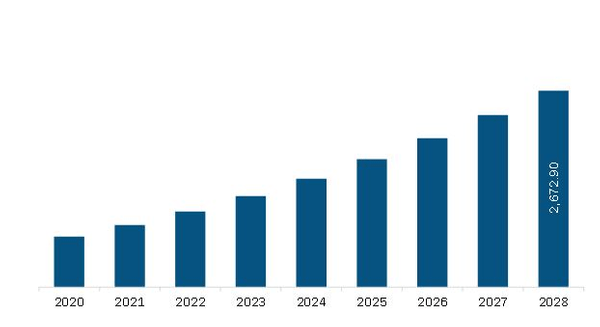
Published On: Mar 2022

Published On: Mar 2022

Software and Services Segment has the Largest Share of Component in the North America 3D Printing Medical Devices Market during 2021–2028
According to our latest study on “North America 3D Printing Medical Devices Market Forecast to 2028 – COVID-19 Impact and Analysis – by Component, Technology, Application, and End-User,” the market is projected to reach US$ 2,672.9 million by 2028 from US$ 848.0 million in 2021; it is expected to grow at a CAGR of 17.8% from 2021 to 2028. The report highlights trends prevailing in the market, and the drivers and restraints pertaining to the market growth. The growth of this market is estimated to grow owing to key driving factors such as the rising incidences of cancer and increasing adoption of metabolomics and investments by market players. However, high cost of tools, instruments, and usage is expected to restrict the market growth during the forecast period.
The current COVID-19 outbreak has highlighted the importance of 3D printing in addressing key shortages in the medical product supply chain. The 3D-printing industry is currently focused on the United States and Western Europe. Beginning in March 2020, the medical community in the United States faced extraordinary shortages of personal protective equipment (PPE), PPE attachments, and medical instruments needed to treat COVID-19 patients. Individuals and businesses in the United States designed and manufactured additively built PPE, PPE attachments, and medical gadgets in response to the needs of the healthcare community. As a result of the pandemic, access to clients to sell and implement 3D printing medical devices decreased in March 2020 and during the second quarter of 2020, as hospitals focused solely on the COVID-19 epidemic. The epidemic has resulted in a huge surge in ventilator demand. Manufacturing facility closures due to lockdowns and interrupted supply chains had a minor impact on the geographical growth of the 3D Printing Medical Devices market in 2020. Established vendors are backed up the increasing demand and helped to alleviate crucial shortages of nasopharyngeal swabs and face shields. Field-ready, individually packaged, sterile 3D-printed nasopharyngeal swabs and face shields were produced by the company.
Based on component, the 3D printing medical devices market is segmented into software and services, equipment, and material. In 2021, the material segment accounted for the largest share. Moreover, the software and services segment is expected to grow at the highest CAGR during the forecast period.
EOS GmbH Electro Optical Systems, Renishaw PLC, Stratasys Ltd., 3D Systems, Inc., EnvisionTech, Inc., Concept Laser Gmbh (General Electric), Proadways Group, SLM Solution Group AG, and CELLINK are among the leading companies in the North America 3D printing medical devices market. The companies are focused on adopting organic growth strategies such as product launches and expansions to sustain their position in the dynamic market.
The market for 3D printing medical devices market is segmented into component, technology, application, and end-user. Based on component, the North America 3D printing medical devices market is segmented into software and services, equipment, and material. Based on technology, the 3D printing medical devices market is segmented into laser beam melting, photopolymerization, droplet deposition/extrusion based technology, electron beam melting, and others. Based on application, the North America 3D printing medical devices market is segmented into custom prosthetics and implants, surgical guides, tissue engineering products, surgical instruments, hearing aids, wearable medical devices, standard prosthetics and impants, and others. Based on end-user, the North America 3D printing medical devices market is segmented into hospitals and surgical centers, dental and orthopedic centers, medical device companies, pharmaceutical and biotechnology companies, academic and research institutions, others. Geographically, the 3D printing medical devices market is segmented into North America (US, Canada, Mexico).
North America 3D Printing Medical Devices Market, By Country, 2021 and 2028 (%)
Contact Us
Phone: +16467917070
Email Id: sales@businessmarketinsights.com